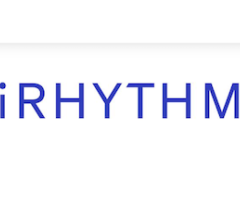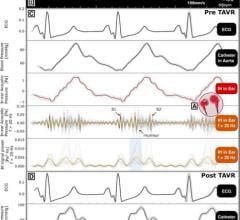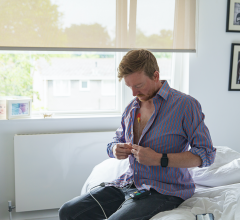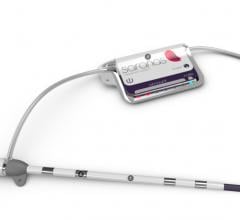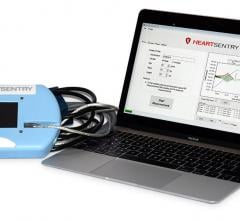
FDA cleared in March, the Masimo Rainbow SET Rad-57cm Pulse CO-Oximeter is a handheld, continuous monitor that analyzes data from an 8-wavelength finger sensor to accurately measure arterial oxygen saturation, carbon monoxide, methemoglobin and pulse rate.
Patient monitoring technologies have played a crucial role in the development of anesthesiology practice within the U.S. Because anesthesiology involves many inherent risks that are difficult, if not impossible, to eliminate, anesthesiologists often turn to advanced patient monitoring technologies to ensure safety during a procedure. It’s no wonder that anesthesiology has been a field of medicine that has made enormous contributions to the enhancement of patient safety throughout this country.
Pulse oximetry and capnography have been two of the most notable examples of monitoring methods that have had a huge impact on patient safety during critical care procedures. In the last quarter of the 20th century they became essential for monitoring patients during surgery and general anesthesia. Today, technological advancements have broadened their potential applications while also improving the level of care in their traditional role as surgical monitors. At the same time, new innovations are allowing doctors to directly measure parameters that previously could only be indirectly detected.
Expanded Use of Capnography
It has been long understood that capnography is essential to critical care monitoring for patients undergoing general anesthesia. While pulse oximetry provides valuable data about blood oxygenation levels, it only offers indirect information pertaining to respiratory health.
The development of capnographs addressed this issue by providing a way to measure carbon dioxide (CO2) in the ventilation of a patient connected to an anesthesia administration device. By directly analyzing the patient's breathing, the capnograph can provide critical vital signs information regarding the patient's interaction with the anesthesia administration. Abnormal levels of CO2 in the patient's breathing may be signals of an adverse respiratory event, such as hypoxia. Making a clear contribution to the enhancement of patient safety, capnographs have become standard monitoring tools for the OR for nearly two decades and have populated ICUs as well.
More recent research has suggested that capnography may have applications outside of the OR or ICU. Over the past two years medical researchers have found evidence that capnography can serve as an early warning system for patients undergoing pain therapy. Certain patients, such as those with asthma or sleep apnea, may be at an elevated risk of respiratory depression during patient controlled analgesia (PCA). Research studies have suggested that clinicians use capnography on patients receiving PCA therapy if the patients have risk factors that increase the chance of an adverse respiratory event.
Earlier this year, an article in the American Journal of Health-System Pharmacy suggested that capnography be used for all patients receiving PCA therapy, not just those pre-disposed to higher risk factors.
Similarly, patients undergoing conscious sedation during outpatient procedures such as endoscopy may receive significant safety benefits from capnography. According to an article from the journal Gastrointestinal Endoscopy Clinics of North America, the incidence of anesthesia-related deaths has dramatically declined since capnography monitoring was mandated in the U.S. for patients under general anesthesia. Meanwhile, the authors of the article conclude that over the past 20 years the incidence of cardiopulmonary complications during endoscopy has not declined, despite regular pulse oximetry monitoring. This has prompted some to begin considering the potential use of capnography within this setting.
Although there has been clinical evidence to suggest that capnography can be useful outside of the OR environment, the technology has not expanded to other areas of the hospital until recently. This is partially due to technical limitations that have inhibited clinicians from using capnography on the general floor in nonintensive care environments.
One company that has helped lead the way in breaking through the technical barriers that once inhibited capnography is Oridion. By designing small, portable devices that can operate effectively outside of the OR environment, Oridion has helped expand the number of applications for capnography monitoring.
As companies continue to innovate in this area and research continues to show the benefits of this monitoring technology, we can expect to see further patient safety enhancements throughout the hospital for various forms of sedation, pain management or anesthesia.
Introduction of Cerebral Oximetry
Brain injury from lack of oxygenation can be one of the most devastating consequences of a complication during anesthesia. Most of the widely used patient monitoring technologies take systematic measurements that do not always offer information about oxygenation of a particular region. Meanwhile, research has shown that brain injury can occur despite normal values of systemic oxygenation. As mentioned previously, anesthesiology involves many inherent risks, which is why vigilance is so important. However, current monitoring methods may not adequately monitor patients for the prevention of brain injury during anesthesia.
Fortunately, cerebral oximetry offers a noninvasive means for continuous monitoring of brain oxygenation. The technology is much newer than capnography or pulse oximetry. It first became available in the mid-1990s and is now gaining broader acceptance. It works by using near-infrared light signals to detect regional oxyhemoglobin saturation.
Since this method offers more specific data about brain oxygenation, it can be a much more useful tool for detecting potentially injurious events. Moreover, studies have shown that often only minor adjustments are necessary to correct problematic developments detected through cerebral oximetry.
Informing critical care providers when minor modifications can prevent catastrophic injury or death, cerebral oximetry not only helps save lives but also saves both families and the healthcare system enormous grief and financial hardship.
Given the consequences that can accompany brain injury resulting from anesthesia, more hospitals and doctors may begin to investigate expanded implementation of cerebral oximetry in their ORs. Cerebral oximeters may be especially useful for neonatal and pediatric patients, since the light path will reach deeper neural structures. Furthermore, with brain injuries accounting for a large portion of malpractice claims against anesthesiologists, there may be additional motivation to establish new safety standards in this particular area.
Somanetics' INVOS and CAS Medical’s FORE-SIGHT are two FDA-cleared cerebral oximeter devices for continuous noninvasive monitoring of regional oxygen saturation in the brain — and Somanetics is the only simultaneous cerebral-somatic oximeter cleared by the FDA.
Continued Advancement
Healthcare companies are looking at many other areas, too, in which to explore and apply new technologies that may help improve patient monitoring capabilities. We have seen how technological progress has arisen when traditional technologies were either incapable of monitoring a specific parameter or could only provide indirect measurements.
There are also situations when clinicians have the ability to directly measure a specific parameter, but they cannot do so continuously. This type of monitoring requires a point-of-care diagnostic test to analyze a sample that is drawn from the patient and tested during the procedure. The inefficiency of this cumbersome form of monitoring can eventually motivate the development of new technologies that can offer continuous monitoring of a parameter that could only be measured intermittently.
Improving the efficiency of patient monitoring during critical care can greatly enhance patient safety by enabling medical staff to focus more directly on patient care and reducing the time spent on point-of-care diagnostics. Therefore, innovations that improve monitoring capabilities and increase efficiency can make a significant impact on critical care and patient safety.
A good example of this type of innovation is Masimo's new line of pulse co-oximeters, the Radical-7 and the Rad-57. In addition to providing traditional pulse oximetry measurements, Masimo's co-oximeters also provide continuous noninvasive measurement of carbon monoxide and methemoglobin. Without this technology, doctors must draw blood and analyze the sample in order to determine levels of carbon monoxide within a patient's blood. Masimo’s new technology allows for this to been done continuously and noninvasively.
Another area that may call for improvements is glucose monitoring. Noninvasive continuous glucose monitoring may have significant potential for anesthesia monitoring applications.
While no FDA-approved device with this capability currently exists, blood glucose is a parameter that has received significant attention from anesthesiologists. A recent publication from the American Society of Anesthesiologists stated, “It is now obvious that blood glucose plays a key role in the short- and long-term consequences of neurologic injury.” The piece went on to discuss that blood glucose variability, as well as blood glucose level, should be investigated as possibly requiring perioperative monitoring.
As this research continues, both anesthesiologists and patients will be able to benefit from these patient safety advances. Pulse oximetry, capnography and cerebral oximetry have all demonstrated how close patient monitoring during anesthesia can help avoid medical emergencies, shorten hospital stays and improve recovery times.
Device manufacturers have indicated that we can expect significant progress in the performance and versatility of traditional monitoring methods, such as capnography and pulse oximetry. Moreover, we can expect the introduction of advanced monitoring innovations, such as cerebral oximetry, which will further enhance the quality of critical care and promote the advancement of patient safety throughout the health system.
Michael Addison is a market analyst with Frost & Sullivan. He can be reached at [email protected].




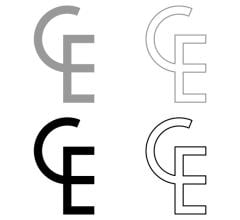
 October 21, 2025
October 21, 2025 


